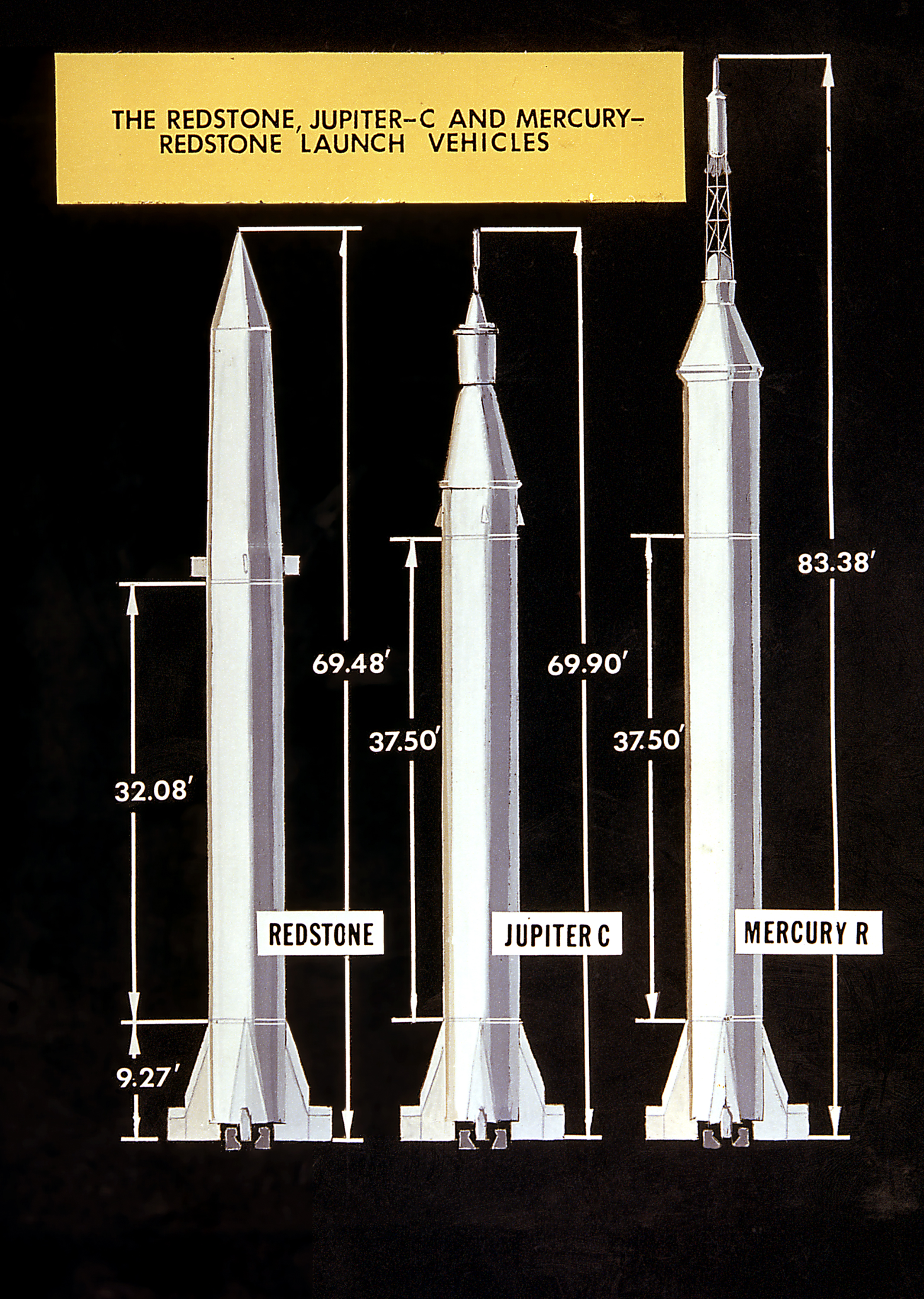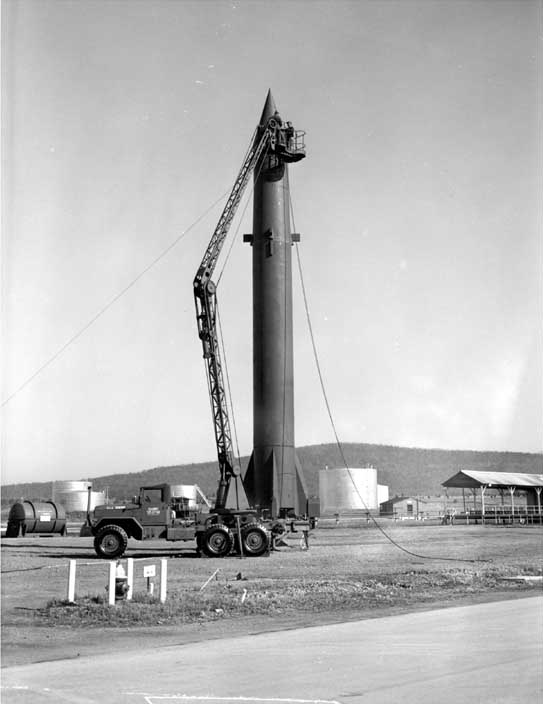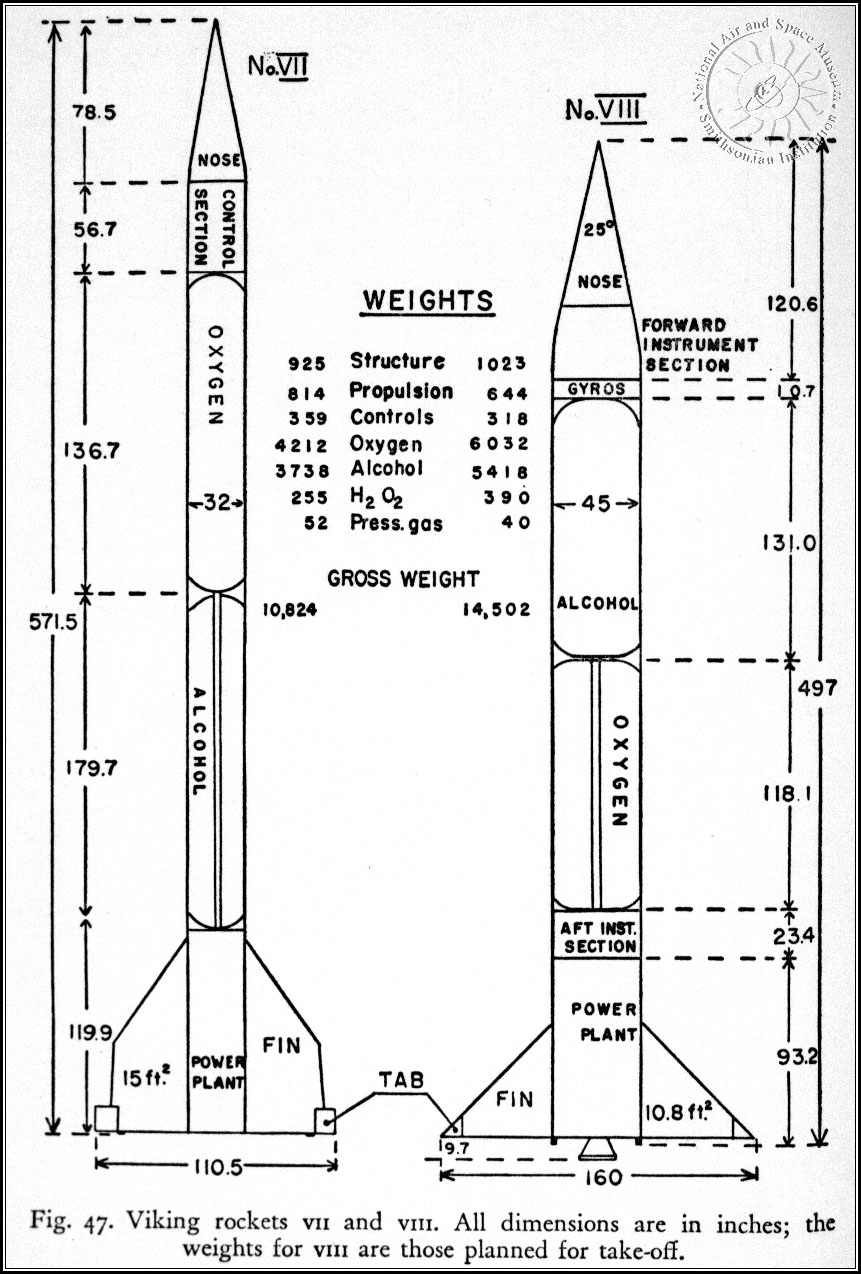|
Jupiter-C
The Jupiter-C was an American research and development vehicle developed from the Jupiter-A. Jupiter-C was used for three unmanned sub-orbital spaceflights in 1956 and 1957 to test re-entry nosecones that were later to be deployed on the more advanced PGM-19 Jupiter mobile missile. The recovered nosecone was displayed in the Oval Office as part of President Dwight D. Eisenhower's televised speech on November 7, 1957. A member of the Redstone rocket family, Jupiter-C was designed by the U.S. Army Ballistic Missile Agency (ABMA), under the direction of Wernher von Braun. Three Jupiter-C flights were made followed by three satellite launches (Juno I). All were launched from Cape Canaveral, Florida. Description Each vehicle consisted of a modified Redstone ballistic missile with two solid-propellant upper stages. The tanks of the Redstone were lengthened by 8 ft (2.4 m) to provide additional propellant. The instrument compartment was also smaller and lighter than the Reds ... [...More Info...] [...Related Items...] OR: [Wikipedia] [Google] [Baidu] |
Army Ballistic Missile Agency
The Army Ballistic Missile Agency (ABMA) was formed to develop the United States Army, U.S. Army's first large ballistic missile. The agency was established at Redstone Arsenal on 1 February 1956, and commanded by Major General John Bruce Medaris, John B. Medaris with Wernher von Braun as technical director. History The Redstone (rocket), Redstone missile was the first major project assigned to ABMA. The Redstone was a direct descendant of the V-2 missile developed by the von Braun team in Germany during World War II. After the Naval Research Laboratory's Project Vanguard was chosen by the United States Department of Defense, DoD Committee on Special Capabilities, over the ABMA's proposal to use a modified Redstone (rocket), Redstone ballistic missile as a satellite launch vehicle, ABMA was ordered to stop work on launchers for satellites and focus, instead, on military missiles. Von Braun continued work on the design for what became the Jupiter-C rocket. This was a three-st ... [...More Info...] [...Related Items...] OR: [Wikipedia] [Google] [Baidu] |
Explorer 1
Explorer 1 was the first satellite launched by the United States in 1958 and was part of the U.S. participation in the International Geophysical Year (IGY). The mission followed the first two satellites the previous year; the Soviet Union's Sputnik 1 and Sputnik 2, beginning the Cold War Space Race between the two nations. Explorer 1 was launched on 1 February 1958 at 03:47:56 GMT (or 31 January 1958 at 22:47:56 Eastern Time) atop the first Juno booster from LC-26A at the Cape Canaveral Missile Test Center of the Atlantic Missile Range (AMR), in Florida. It was the first spacecraft to detect the Van Allen radiation belt, returning data until its batteries were exhausted after nearly four months. It remained in orbit until 1970. Explorer 1 was given Satellite Catalog Number 00004 and the Harvard designation 1958 Alpha 1, the forerunner to the modern International Designator. Background The U.S. Earth satellite program began in 1954 as a joint U.S. Army and U.S. Navy pr ... [...More Info...] [...Related Items...] OR: [Wikipedia] [Google] [Baidu] |
Jupiter-A
The Redstone family of rockets consisted of a number of American ballistic missiles, sounding rockets and expendable launch vehicles operational during the 1950s and 1960s. The first member of the Redstone family was the PGM-11 Redstone missile, from which all subsequent variations of the Redstone were derived. The Juno 1 version of the Redstone launched Explorer 1, the first U.S. orbital satellite in 1958 and the Mercury-Redstone variation carried the first two U.S. astronauts into space in 1961. The rocket was named for the Redstone Arsenal in Huntsville, Alabama where it was developed. PGM-11 Redstone First launched in 1953, the PGM-11 Redstone was a short-range surface-to-surface ballistic missile in active service with the U.S. Army from June 1958 to June 1964; and was used for the first U.S. live nuclear missile tests. It was built by Chrysler for the United States Army Ballistic Missile Agency (ABMA) and was deployed in West Germany. George Huebner was the executive engin ... [...More Info...] [...Related Items...] OR: [Wikipedia] [Google] [Baidu] |
Juno I
The Juno I was a four-stage American space launch vehicle, used to launch lightweight payloads into low Earth orbit. The launch vehicle was used between January 1958 to December 1959. The launch vehicle was a member of the Redstone launch vehicle family, and was derived from the Jupiter-C sounding rocket. It is commonly confused with the Juno II launch vehicle, which was derived from the PGM-19 Jupiter medium-range ballistic missile. In 1958, a Juno I launch vehicle was used to launch America's first satellite, Explorer 1. History Developed as a part of the Explorer Project, the original goal for the launch vehicle was to place an artificial satellite into orbit. Following the Soviet Union's launch of Sputnik 1 on October 4, 1957 (and the resulting " Sputnik crisis") and the failure of the Vanguard 1 launch attempt, the program received funding to match the Soviet space achievements. The launch vehicle family name was proposed in November 1957 by Jet Propulsion Labora ... [...More Info...] [...Related Items...] OR: [Wikipedia] [Google] [Baidu] |
Redstone (rocket Family)
The Redstone family of rockets consisted of a number of American ballistic missiles, sounding rockets and expendable launch vehicles operational during the 1950s and 1960s. The first member of the Redstone family was the PGM-11 Redstone missile, from which all subsequent variations of the Redstone were derived. The Juno 1 version of the Redstone launched Explorer 1, the first U.S. orbital satellite in 1958 and the Mercury-Redstone variation carried the first two U.S. astronauts into space in 1961. The rocket was named for the Redstone Arsenal in Huntsville, Alabama where it was developed. PGM-11 Redstone First launched in 1953, the PGM-11 Redstone was a short-range surface-to-surface ballistic missile in active service with the U.S. Army from June 1958 to June 1964; and was used for the first U.S. live nuclear missile tests. It was built by Chrysler for the United States Army Ballistic Missile Agency (ABMA) and was deployed in West Germany. George Huebner was the executive engi ... [...More Info...] [...Related Items...] OR: [Wikipedia] [Google] [Baidu] |
PGM-19 Jupiter
The PGM-19 Jupiter was the first nuclear armed, medium-range ballistic missile (MRBM) of the United States Air Force (USAF). It was a liquid-propellant rocket using RP-1 fuel and LOX oxidizer, with a single Rocketdyne LR79-NA (model S-3D) rocket engine producing of thrust. It was armed with the W49 nuclear warhead. The prime contractor was the Chrysler Corporation. The Jupiter was originally designed by the US Army, which was looking for a highly accurate missile designed to strike enemy states such as Communist China and USSR. The US Navy also expressed an interest in the design as an SLBM but left the collaboration to work on their Polaris. Jupiter retained the short, squat shape intended to fit in naval submarines. Development history Initial concept Jupiter traces its history ultimately to the PGM-11 Redstone missile, the US's first nuclear ballistic missile. While it was entering service, Wernher von Braun's Army Ballistic Missile Agency (ABMA) team at Redstone Ars ... [...More Info...] [...Related Items...] OR: [Wikipedia] [Google] [Baidu] |
Cape Canaveral Air Force Station Launch Complex 5
Cape Canaveral Launch Complex 5 (LC-5) was a launch site at Cape Canaveral Space Force Station, Florida used for various Redstone and Jupiter launches. It is most well known as the launch site for NASA's 1961 suborbital Mercury-Redstone 3 flight, which made Alan Shepard the first American in space. It was also the launch site of Gus Grissom's July, 1961, Mercury-Redstone 4 flight. The Mercury-Redstone 1 pad abort, Mercury-Redstone 1A, and the January, 1961, Mercury-Redstone 2 with a chimpanzee, Ham, aboard, also used LC-5. A total of 23 launches were conducted from LC-5: one Jupiter-A, six Jupiter IRBMs, one Jupiter-C, four Juno Is, four Juno IIs and seven Redstones. The first launch from the complex was a Jupiter-A on July 19, 1956 and the final launch was Gus Grissom's ''Liberty Bell 7'' capsule on July 21, 1961. LC-5 is located next to the Air Force Space and Missile Museum which is located at LC-26. The original launch consoles and computers are on display in the LC-5 bloc ... [...More Info...] [...Related Items...] OR: [Wikipedia] [Google] [Baidu] |
PGM-11 Redstone
The PGM-11 Redstone was the first large American ballistic missile. A short-range ballistic missile (SRBM), it was in active service with the United States Army in West Germany from June 1958 to June 1964 as part of NATO's Cold War defense of Western Europe. It was the first US missile to carry a live nuclear warhead, in the 1958 Pacific Ocean weapons test, Hardtack Teak. The Redstone was a direct descendant of the German V-2 rocket, developed primarily by a team of German rocket engineers brought to the United States after World War II. The design used an upgraded engine from Rocketdyne that allowed the missile to carry the W39 warhead which weighed with its reentry vehicle to a range of about . Redstone's prime contractor was the Chrysler Corporation. The Redstone spawned the Redstone rocket family which holds a number of firsts in the US space program, notably launching the first US astronaut. It was retired by the Army in 1964 and replaced by the solid-fueled MGM-31 Per ... [...More Info...] [...Related Items...] OR: [Wikipedia] [Google] [Baidu] |
Redstone (rocket)
The PGM-11 Redstone was the first large American ballistic missile. A short-range ballistic missile (SRBM), it was in active service with the United States Army in West Germany from June 1958 to June 1964 as part of NATO's Cold War defense of Western Europe. It was the first US missile to carry a live nuclear warhead, in the 1958 Pacific Ocean weapons test, Hardtack Teak. The Redstone was a direct descendant of the German V-2 rocket, developed primarily by a team of German rocket engineers brought to the United States after World War II. The design used an upgraded engine from Rocketdyne that allowed the missile to carry the W39 warhead which weighed with its reentry vehicle to a range of about . Redstone's prime contractor was the Chrysler Corporation. The Redstone spawned the Redstone rocket family which holds a number of firsts in the US space program, notably launching the first US astronaut. It was retired by the Army in 1964 and replaced by the solid-fueled MGM-31 Per ... [...More Info...] [...Related Items...] OR: [Wikipedia] [Google] [Baidu] |
Wernher Von Braun
Wernher Magnus Maximilian Freiherr von Braun ( , ; 23 March 191216 June 1977) was a German and American aerospace engineer and space architect. He was a member of the Nazi Party and Allgemeine SS, as well as the leading figure in the development of rocket technology in Nazi Germany and later a pioneer of rocket and space technology in the United States. As a young man, von Braun worked in Nazi Germany's rocket development program. He helped design and co-developed the V-2 rocket at Peenemünde during World War II. Following the war, he was secretly moved to the United States, along with about 1,600 other German scientists, engineers, and technicians, as part of Operation Paperclip. He worked for the United States Army on an intermediate-range ballistic missile program, and he developed the rockets that launched the United States' first space satellite Explorer 1 in 1958. He worked with Walt Disney on a series of films, which popularized the idea of human space travel in ... [...More Info...] [...Related Items...] OR: [Wikipedia] [Google] [Baidu] |
Hydyne
Hydyne is a mixture of 60% unsymmetrical dimethylhydrazine (UDMH) and 40% diethylenetriamine (DETA), developed in 1957 at Rocketdyne for use in liquid-fuel rockets.Morgan, George. It was created by Mary Sherman MorganAmerica's First Lady of Rocketry Caltech News, California Institute of Technology, Vol.42, No.1. Hydyne was used as the fuel for the first stage of the Juno I rocket that launched Explorer 1, the first successful satellite launch conducted by the United States. Improved performance In 1955 Wernher von Braun, employed by the U.S. Army, calculated his Redstone rocket could launch a satellite into orbit if its performance could be improved. A contract to develop a more powerful propellant was awarded to the Redstone's main stage builder, Rocketdyne. The contract required the replacement of the PGM-11 Redstone fuel (including 25% water and 75% ethyl alcohol) with a compound that would boost the rocket's performance by at least 8%. Mary Sherman Morgan was assigned to he ... [...More Info...] [...Related Items...] OR: [Wikipedia] [Google] [Baidu] |
Viking Rocket
Viking was series of twelve sounding rockets designed and built by the Glenn L. Martin Company under the direction of the U.S. Naval Research Laboratory (NRL). Designed to supersede the German V-2, the Viking was the most advanced large, liquid-fueled rocket developed in the United States in the late 1940s, returning valuable scientific data from the edge of space between 1949 and 1955. Viking 4, launched in 1950, was the first sounding rocket to be launched from the deck of a ship. After twelve flights, the Viking was adapted into the first stage for the Vanguard rocket, which launched America's second satellite into orbit in 1958. Origins After World War II, the United States experimented with captured German V-2 rockets as part of the Hermes program. Based on these experiments the U.S. issued a contract 21 August 1946 to the Glenn L. Martin Company for a series of ten large liquid-fueled rockets. The intent was to provide an independent U.S. capability in rocketry, to co ... [...More Info...] [...Related Items...] OR: [Wikipedia] [Google] [Baidu] |





